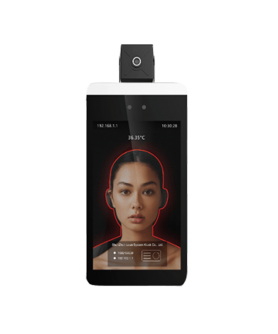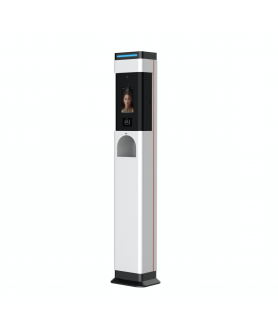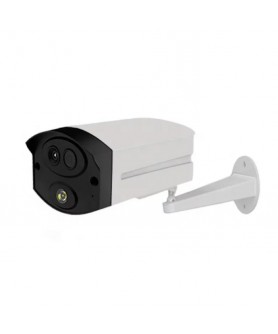ADA-compliant / NDAA-compliant / HIPAA-compliant
Temperature Scanners
Smart Access Kiosk (comes w/Wall Mount) / ADA Compliant
$749 Ex Tax: $749
The HealthGuard Technology Smart Access Kiosk is a body temperature reader with face recognition. It features a multi-use mounting system with desk st..
Smart Access Kiosk with 2-Foot Stand / ADA Compliant
$899 Ex Tax: $899
The Smart Access Kiosk with a 2-foot Stand is a body temperature scanner with face recognition. It offers quick and accurate temperature readings to s..
Smart Access Kiosk with 4-Foot Stand / ADA Compliant
$899 Ex Tax: $899
The HealthGuard Technology Smart Access Kiosk is engineered to scan body temperature, identify an individual’s face, and allow/disallow entry to emplo..
Smart Sanitizing Hub / ADA Compliant
$999 Ex Tax: $999
The Healthguard Technology Smart Sanitizing Hub is an automatic hand sanitizer dispenser with face recognition and thermal scan. It offers temperature..
Thermal Security Camera
$2,499 Ex Tax: $2,499
The HealthGuard Technology Thermal Security Camera is designed for surveillance, identification of people’s faces, and detecting fever-like symptoms i..
As business owners and organizations around the world continue reopening, they’re trying to find the safest ways possible to operate. Companies need to create an environment where their employees feel safe so they can confidently do their jobs.
Aside from wearing masks and social distancing, throughout this pandemic we have learned that one of the fastest and most accurate ways to tell if someone has a fever (a common symptom in detecting Covid-19), is to use a body temperature scanner. Not only is it CDC recommended, but a temperature scanner enables companies to measure a person’s temperature immediately when they walk through the door, and most importantly with no contact whatsoever. It’s imperative that business owners purchase a non-contact temperature scanner thermometer, because it eliminates the disinfection process that other methods require and keeps your employees and customers feeling safe.
How infrared temperature scanners work
Whether it’s wall-mounted or stationary, using an infrared temperature scanner is critical in preventing the spread of COVID-19. These non-contact devices measure from a distance in a fast, efficient manner. An IR temperature scanner doesn’t really measure a person’s temperature—the laser beam is non-invasive and uses no radiation, but instead carefully detects the radiated energy from the surface of a person’s temperature.
A higher body heat (temperature) means faster moving molecules. As these molecules move around, they emit an infrared radiation, and as they get hotter, they may start to emit visible light. Infrared thermometers detect and measure this radiant energy and will automatically convert it into an electronic signal, which then shows a thermal image with temperature calculations.
Capabilities
As these thermal cameras measure people’s body temperatures, they can be set to send an instant notification when a fever is detected. Some temperature scanning cameras even have integration with mobile apps, which will let you view temperature readings directly from your iOS or Android device. You can even set up your thermal camera to integrate with your control system, which is designed to permit entry to authorized users or entry after being scanned for metals.
Types of infrared temperature scanners
There are many different types of infrared temperature scanners but the main three are spot infrared thermometers, infrared scanning systems, and infrared thermal imaging cameras. Spot infrared thermometers provide a non-contact temperature reading from a small area of an object at a specific spot, for example the forehead. The spot thermometers will also require medical personnel or an employee to stand and operate these devices. Infrared scanning systems can typically screen larger areas at a longer distance. Infrared thermal imaging cameras use many detectors to measure the temperature of multiple spots over a larger surface which will produce a 2D image on a screen. A business or organization owner should assess their space first so they can accurately choose which type of infrared temperature scanner is the best option to fit their needs.
While some companies might hire someone to stand at their entrance and operate a spot infrared thermometer—more commonly known as a forehead temperature scanner—this can lead to a few problems. Depending on temperature guns will undoubtedly cause crowds at your entrance while employees and customers wait their turn. As we know, big crowds increase the likeliness of transmitting COVID-19. Additionally, you’ll either have to pay an extra person to operate the device, or your employee will have less time to focus on their job—both less than ideal situations. The most cost-effective way to conduct temperature checks is with an infrared temperature camera or thermal imaging camera.
Infrared temperature scanners vs thermal cameras
You may not know the difference between an infrared temperature scanner and a thermal imaging camera. Both devices are used to sense an object with infrared radiation and turn that into a temperature reading. An infrared temperature scanner uses a specific sensor called a thermopile, which turns the incoming infrared radiation into heat using tiny thermocouples. The thermocouples convert that heat into an electrical signal that is measured and displayed on your device in the form of a temperature reading.
Infrared temperature scanners are a cost-effective way to get a non-contact temperature reading; however, they can only read temperatures for a single spot, making them very inefficient for big spaces. On the other hand, thermal imaging cameras use a focal plane array sensor, which has multiple pixel dimensions that each act as a sensing element, which provides many temperature points on each thermal imaging screen. These advanced optics allow the thermal imaging cameras to detect temperatures accurately from greater distances.
Cost
There are many different infrared temperature scanners available online, all with varying levels of accuracy and price point. The average accuracy level of an IR thermometer is typically ± 3.5° F, and you can easily find these devices on a budget for as little as $15-$20 or opt for a more professional level IR thermometer, which can cost up to $150.
There are a few important steps to take when using a non-contact, infrared temperature scanner. Make sure the person is standing 2-6 inches away from the device and ask them to remove anything like hats or glasses that may get in the way of the reading. Point the device at the inside corner of the person’s eye, holding the scanner still. The temperature should appear on screen within seconds.
On the other end of the spectrum, there is another temperature scanner that typically costs $1,000 or more. The main difference between the two, and possibly the reason for such a price variance, the thermal imaging camera is much more accurate, typically ± 0.6° F. With something as serious as Coronavirus, it’s important to be as accurate as possible. A temperature scanner can quickly scan a single subject or multiple subjects for an elevated body temperature in public places, offices, and more. For the best results, screen one person at a time and at 3-6.5 feet.
Before purchasing a temperature scanner, business owners have to examine their budgets, decide where to place their scanner (and whether it will be mounted or stationary) and lastly, they have to decide how accurate they’d like their temperature readings to be.








